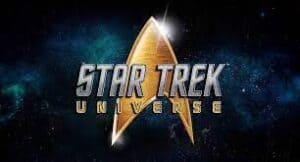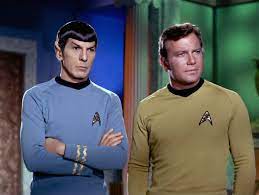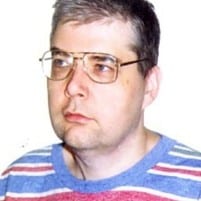Star Trek, conceived by Gene Roddenberry, officially premiered on NBC on September 8, 1966, with the very psychologically appealing core of half-human/half-Vulcan science officer Spock (reason), Dr. McCoy (emotion), and Captain Kirk (the reconciler of the two). The earlier-produced pilot-episode, „The Cage” — with Captain Pike and a female first officer („Number One”) — had been considered as „too cerebral.” ST has grown into a worldwide media super-phenomenon, despite the cancellation of the original series (TOS or „classic Trek” or „Trek Classic” to current-day enthusiasts) after only three years. In 1973-1974, there was the animated series (TAS). A year’s worth of episodes were written for a proposed revival in 1978 (Star Trek II), but none were ever produced, although certain script elements from these were incorporated into later efforts. Star Trek was decisively revived with a succession of big-screen movies, beginning in 1979, and three new television series, ST: The Next Generation (TNG) (September 1987-May 1994); ST: Deep Space 9 (DS9) (January 1993-May 1999); and ST: Voyager (January 1995-May 2001). In September 2001, a new Star Trek series, Enterprise, had premiered, which came to a conclusion in May 2005.

Born in the period of the Sixties’ revolutions, Star Trek has evolved along with the liberal Zeitgeist. While TOS may look „old-fashioned” by today’s standards, it was initially seen as very „cutting edge” and „dangerously modern.” Reading about some of the problems Roddenberry encountered in getting his show underway, one is struck by what today would seem the almost unbelievable conservatism of senior television people, a group rarely thought of as conservative. Nevertheless, Roddenberry persevered in putting forth his then-radical ideas, nearly all of which (ironically) seem completely tame and uncontroversial when considered from the current-day context. For example, the first interracial kiss on network television occurred in Star Trek. (And it was actually portrayed as occurring under an alien’s „mind-control compulsion.” It may indeed be difficult to believe how stubbornly conservative and prudish American society appeared to be, little more than fifty years ago.) Spock’s rather „devilish” appearance was also extremely controversial.
The choice of the name Spock was interesting in itself. Whether deliberately so chosen, or as a curious synchronicity, it recalls the Dr. Benjamin Spock whose liberal child-rearing ideas were an important though infrequently discussed contributing factor to the whole concatenation of 1960s revolutions. One may indeed speak of both Dr. Spock’s and the Star Trek Spock’s „children” or „generation.” (It may be somewhat amusing that on at least one occasion in TOS, Spock was addressed as „Doctor Spock” — as he is said to have a degree in astrophysics.)
The extent to which we may see TOS as „socially conservative” today shows the precipitous evolution of the spirit of the current age. One of the most obvious differences between TOS and later series was fewer aliens in the former, especially among Federation crewmembers, as well as the more pronounced national identifications of the human crew (e.g., Scotty, Chekhov, Sulu, Uhura). Some conservatives have termed the more recent Star Trek series „a freakshow.” The feeling is that the parade of aliens undermines the sense of a natural human image.
TNG introduced a whole new set of characters, which could easily be expressed in liberal stereotypes. Jean-Luc Picard was a far more intellectual Captain, a sort of enlightened CEO. His First Officer, Riker, was a sort of JFK clone. Deanna Troi was the psychological counsellor. Dr. Beverly Crusher was the hard-as-nails female physician. Tasha Yar was the feminist warrior. Geordi La Forge, Black and visually-impaired, was one minority figure. Data, the android, was the machine in search of humanity. The other minority was Worf, a Klingon. Although, as somewhat of a token „conservative” or „traditionalist” he often protested the liberal actions of the other crewmembers, he always seemed to go along in the end. Somewhat later in TNG’s evolution, Whoopi Goldberg came on as Gainan, the all-knowing, infinitely wise Black woman.
Over the decades, the Klingons had evolved, in a process very typical of Star Trek, from a villainous, imperial race (with few redeeming qualities), to something more akin to ancient warrior-societies (with a pronounced sense of honor), although, as part of the metamorphosis, they were actually initially made far more physically ugly (in the first Star Trek movie). In what is perhaps an attestation to the ultimate triviality of a show sometimes taken so seriously, one of the reasons cited for the “uglification” of the Klingons was a surplus in the movie’s make-up budget! Another anecdote pointing to ultimate triviality was that, at one point, the Klingon ceremonial weapon was apparently copied from an earlier trading card image. (It had made a brief appearance it an earlier Trek production.) Another attestation to ultimate triviality is that many of the Klingon uniforms were based on recycled outfits from The Planet of the Apes movies (i.e., the uniforms of the evil gorilla soldiers, of which huge numbers had apparently been produced). This probably turned the portrayal of the Klingons in a more savage and barbaric direction, than otherwise might have been the case. It was a curious process by which the Klingons were physically uglified and then somewhat redeemed, as a great warrior-race. To not physically uglify them in the first place was something that would have gone against the grain of the typical American mindset.
Deep Space 9 (DS9) was another setting, a space station above Bajor, a troubled planet that had recently been occupied by the Cardassians, an evil, rather hideous-looking race. The withdrawal of the Cardassians had left Bajor divided and in the flux of change, undecided about possibly joining the Federation. The Federation’s Commander of the station, Benjamin Sisko, was an African-American, who was raising his young son alone (Sisko’s wife had perished during the earlier incursion by the Borg aliens). The Commander’s obvious social conservatism and bearing of military discipline were increasingly downplayed in the ongoing episodes, among other things by a change of hairstyle (to bald) and by his growing a beard, giving him a more „cool” and sinister look. The other main figures on DS9 were Major Kira, the Bajoran female officer; Jadzia Dax, a woman linked with a „symbiont”; the often naive Dr. Bashir (an Anglo-Indian who played what in earlier times would have been called „the twitty Englishman” role); and O’Brien (an obviously Irish engineer), who just happens to be married to a somewhat shrewish Japanese woman (Keiko). (Yet another liberal device, bringing together a couple from what are some of our own Earth’s most different societies.) Two alien figures are Odo, who is an apparently unique representative of the shapeshifter race, and is the personification of strict duty as the Constable, and Quark, a Ferengi trader and trickster-figure (who looks like a sort of big-eared goblin), who is his comic foil.

The planet of Bajor is shown as having a kind of traditional culture, with a long-established religion. What seems to not be realized, is that the Bajoran culture would probably be utterly undermined by the explanation that „the Prophets” are really just another race of transdimensional „superbeings” (of which there have been innumerable other examples in the galaxy). DS9’s Hollywood producers also show an extreme naivete in the portrayal of the earlier Bajoran partisan-fighting against the Cardassians, attesting to Hollywood’s all-too-obvious lack of historical knowledge and feeling. For example, it emerges that Odo fulfilled the function of Constable under the Cardassian regime, and that surely would qualify him as a high-ranking collaborator. There was also the case where the Cardassians threatened to destroy several Bajoran villages unless a prominent leader of the resistance surrendered to them. What this ignores is that the occupiers could easily destroy the villages after the leader’s surrender. It is never made clear whether the Cardassians are more „authoritarian” (e.g., like the more typical Western colonial administration of „backward” lands), or „totalitarian” (e.g., like the occupation of Poland by Nazi Germany during World War II). The more „reactionary” Bajorans, however, are predictably condemned, as for example in an episode that alluded to a Bajoran „racist” organization, who wanted „off-worlders off Bajor.” Kai Wynn, one of the leading „traditionalists,” was shown as increasingly, outrightly, evil. The liberal stereotypes about the Jerry Falwells of our own world were thereby again vindicated. The Bajorans were also termed in current-day chatter about the show as „the Palestinians of the 24th century” — a comment that caused some embarrassment, taking into account the analogous identity of the rather hideous and evil Cardassian occupiers.
Voyager, which premiered in 1995, has a female Captain, a Black Vulcan, an American Indian, a half-Hispanic/half-Klingon woman, a holographic doctor in the Spock/Data role, and other exotic elements. In what is perhaps the most gratuitous example of Star Trek’s tendency of absorption of „the other,” there appeared „the Borg babe” (Seven of Nine), a highly attractive female who was once part of the Borg aliens, the Star Trek symbol for the dangers of collectivism and fascist misuse of technology. The ongoing appeal in Star Trek to an often-frustrated „geek” element is also obvious. There was a story in the papers that when the actress playing Ezri Dax joined the DS9 show (after the on-screen demise of Jadzia Dax), she was surprised at the extent to which her outfit was padded to accentuate her breasts. The use of such enhancements is apparently a long-time Trek tradition, going back to TOS itself.
One of the central motifs of Star Trek is that the whole universe is „up for grabs” for conversion to the basically liberal values of the Federation. The main large theme of Star Trek is encounters with various alien races (which obviously represent different, unruly, untamed, more „primitive” or premodern aspects of human existence), and their eventual „humanizing” or „liberalizing” in the direction of Federation values. This could be characterized as a co-opting or co-optation of these dangerous, unruly aspects of human character and historical experience.
It may obviously be argued that the major non-human races in Star Trek are inspired by various archetypal or stereotypical aspects of human character and historical experience — the Klingon warriors, the Ferengi merchants, the mystic Bajorans, the pseudo-Roman Romulans, the collectivist Borg (probably a take on the Japanese), and so forth. In that sense, Star Trek provides a certain series of quick templates (especially in a virtually history-less milieu such as that of late-modern, urban North America) for reaching conclusions about human character and historical experience. However, as will be looked at further below, Star Trek’s „take” on much of human character and historical experience, is overwhelmingly liberal.
What are the values of the Federation, as represented in Star Trek over the years? They could be perceived as being relentlessly secular-humanist and “New Age,” as far as actual human religions are concerned. As far as the author is aware, there has never appeared any emblem or figure of any Earth religion (as such) in any episode of Star Trek, apart from the dying pagan god Apollo (TOS), an „evil angel” (TOS), and an American Indian native spirit (Voyager). (It has only become more generally known much later that the famous Vulcan greeting had actually been derived by the producers from a real-world Jewish observance.) The line from the dying Apollo episode where Kirk says something along the lines that one God is enough for him is frequently cited as an overt reference to religion in TOS. There were also references to the Christians in Rome situation in TOS (featuring a parallel-Earth where Rome had never fallen, and Christianity continued as a small, idealistic, persecuted sect); and in the “Unification” episodes of TNG, on the home planet of the Romulans, with „enlightened Romulans” in the catacombs with Spock as their leader. There was also the episode of TOS that alluded to the Holocaust. The theme of „Spock, Messiah” has also run through many parts of Star Trek, notably, the third movie. An interesting comment on the evolution of the Spock role and its place in popular culture is Leonard Nimoy’s earlier biography, I Am Not Spock (where he pleaded somewhat to be recognized not only for his Spock role), to his latest biography (with his aged and wizened face on the cover), where he simply says, I Am Spock.
Generally-speaking, it may be said that Star Trek mirrors (in virtually every episode and film), Roddenberry’s obsessions with „near-gods,” „failed gods,” „false gods,” and „pseudo-gods,” as well as fictive alien religions and cults – much of which could be seen as highly unsettling variants of Gnostic speculation.
One often finds a stiltedness in many Star Trek plots, too often relying on the deus ex machina (that is, “god from a machine”) (sometimes literally), often based on the quick and highly improbable technological fix. All too often, one finds some god-like superbeing/s introduced near the end of the episode, to be never again seen in a future installment. The classic example of this are the Organians in TOS. Although reference was made to the Organian-imposed peace treaty in a few subsequent episodes, at some point these superbeings simply disappeared from the Star Trek universe.
Another aspect of Star Trek is the old-fashioned-liberal homage which it pays to classical music and art (e.g., Shakespeare). As far as the author is aware, something akin to rock music and similar musical genres, has very rarely appeared in the Star Trek universe. (Although there was an episode of TOS that alluded to Sixties’ hippie culture.) The optimism of Star Trek virtually precludes the appearance of late modern forms of music and art (especially in their more extreme forms), which rather than „soothing the savage beast” (as the old saying goes) — can sometimes be seen as actually contributing to making one into a savage beast. The appearance of rock and rap music (specifically, of their more extreme subgenres) would throw into relief the possible grunge and alienation which the Star Trek future is said to have left far behind. Indeed, the Star Trek future (at least for Earth), appears to be irrepressibly „nice” and optimistic. This stands in strong contrast to the „gritty future” or so-called „air-conditioned nightmare” presented in such works as: Ridley Scott’s Alien and Blade Runner (a brilliant rendering of Philip K. Dick’s Do Androids Dream of Electric Sheep?); Anthony Burgess’ A Clockwork Orange (audaciously filmed by Stanley Kubrick); and in the cyberpunk subgenre of science fiction in general (typified by William Gibson’s Neuromancer).
Star Trek could be seen as not much better than a more positive take on that antiseptic, well-ordered dystopia, Aldous Huxley’s Brave New World. It is also in some ways nothing more than a somewhat elegant updating of the optimistic, super-scientific projections of science-fiction pioneer Hugo Gernsback’s 1920s and 1930s science-fiction and futurism (typified by air-cars, moving sidewalks, and gleaming jumpsuits). It should be noted, however, that the first major „dark-future” film, Fritz Lang’s Metropolis, had also appeared in the 1920s. It could be argued that in current-day, late-modern society, all the promise of a shiny, happy, liberal (so-called) „utopia” (which to a traditionalist, is actually also a dystopia), has moved in the direction of turning into the ashes of a „gritty” dystopia typified by the cityscape, mediascape, and soundscape of Blade Runner.
The Earth of Star Trek’s future is also one where any real national identities are at best superficial. There is not merely a world-government, but an interplanetary and interstellar one. And, as in the real world over the last three decades, there has been a relentless push in Star Trek of advancing the outré and minority tendencies at the expense of more traditional social roles and conventions. White males became increasingly less prominent in the Star Trek shows, and there were often such scenes as, for example, a Black female admiral berating Picard for his stupid mistakes. Indeed, some conservatives have complained that the Federation is effectively a matriarchy. However, some years ago, gay activists had denounced the fact that persons who are unambiguously homosexuals and homosexual couples – as opposed to some situations and characters which hinted at gayness — had hitherto never appeared on Star Trek.
One of the perennial traits of Star Trek is its drive to what could be called „pluralization.” For example, for almost every culture shown, no matter how uniform, conformist, or masculine-ruled in the beginning, there always begin to appear „women and minorities.” For example, there have now appeared „the Black Vulcan,” a few Black Bajorans, an extremely influential female Cardassian leader, and „the Borg Queen” (yet another powerful female figure from that group). Among the Ferengi, who were initially said to standardly keep their females unclothed at home, there has appeared an independent and highly intelligent female, who masquerades as a male of the species.
All this could be seen as paralleling the unceasing, unrelenting „liberationist” drive for placing “the first” woman or minority in virtually every social, political, and cultural institution as well as workplace in Western societies – to be followed by ever-increasing, multifarious “diversity” at every level. And anything that prevents the emergence, for example, of a Black lesbian Pope, tends to risk being denounced by ever more politically-correct opinion-makers as „illegitimate privilege.”
The central principle of Star Trek (discussed in some of the literature, but which never quite made it onto the screen) is said to be IDIC — Infinite Diversity in Infinite Combinations. This is the central principle that Spock is said to be guided by, which is rather ironic, considering how deeply rooted he seems to be in his Vulcan heritage. Indeed, Spock, in the manner of „accredited minorities,” is allowed to celebrate his flourishing and „thick” identity — whereas humans in the Federation have to embrace a definition of IDIC that consists of complete openness and amorphous self-definition, where „the universal idea of human rights” (and its proceduralist „working out”) supersedes one’s own possibility of having what might be seen as a more authentic sense of rootedness and self-worth.
Some persons have identified the economic system of Star Trek as „market socialism,” i.e., business is allowed to exist, but it must turn over most of its profits to „the public good” (probably as defined by Star Fleet or the Federation government). Some screenwriter had also worked in references to the abolition of “animal slavery” in the Star Trek future.
One of the defining moments of Star Trek, as far as the author is concerned, was the premiere episode of TNG, where the Mephistophelean figure of Q (an alien superbeing), briefly takes on the appearance of a stereotypical 1950s American army officer, ranting about „Commies,” to show Captain Picard the „primitiveness” of the human race. Picard flinches away from this representation as if it really were the embodiment of the epitome of human evil! He also says something to the effect that humanity has progressed centuries beyond this „barbarism.” What is also troubling is how easily Picard can identify an image from over three hundred years ago — presumably the Federation education system continues to be steeped in late-twentieth century liberal demonology, expounding on the evils of U.S. militarism, McCarthyism, and Nixon. Q then takes on the role of a villainous presiding judge on a gilded throne, with red and black robes obviously reminiscent of medieval or Renaissance Europe. This scene of Q’s trial of Picard seemed rather symbolic of a „conspiratorial Left” view of America, with Q (the white male overlord), being served by soldiers in thrall to drugs, and eliciting the support of a crowd of poor, raggedly dressed „common-folk.”
It has been noted by some critics that Star Trek often in fact has a rather moralistic or preachy element or tone about it. Many episodes, particularly of TNG, can be interpreted as nothing more than neat liberal „morality-plays,” where the audience is expected — without too much intellectual effort or hesitation — to draw the proper „lesson” or „message” at the conclusion of the episode. One may indeed wonder if this makes Star Trek typical or atypical of current-day film and television efforts. Perhaps Star Trek anticipates the emergence of „political correctness” as a „new morality.”
Star Trek has spawned a huge number of sometimes very intense enthusiasts (the so-called „Trekkies” or „Trekkers”). The passion of this attachment, the memorization of every episode down to the last word, the attendance of conventions which strengthen „the faith,” and so forth, strikes one as an over-concentration of time and effort. Star Trek has sometimes grown to command a greater allegiance in the hearts and minds and ways of life of its followers, than many actual nations and religions that have existed for hundreds or thousands of years. Living in the mostly history-less milieu of late-modern, urban North America, many young persons have been filled with all kinds of ersatz substitutes for „meaning in life.” However, Star Trek is obviously only one of the very many identity options available today. And one should stress that comparatively few of such modern-day identities are total — there is a constant crosscutting and dynamic interplay between the ever-changing and sometimes dizzying array of „roles” one can play. However, most of these „roles” tend to work in a direction that strengthens the current-day system, with virtually all of the „diversity” taking place under a broadly left-liberal banner. For example, one of the lesser-known aspects of Star Trek fandom is a distinct subgenre of fan writing depicting homosexual relationships between Kirk and Spock!
It might be added here, to give some further nuance to the argument, that science fiction fandom is emphatically not monolithic. For example, there are enthusiasts of literary, printed science fiction, who look with varying degrees of disdain at Star Trek or Star Wars fans. Many of the more serious SF fans see Star Trek and Star Wars as „too vulgar,” or „sci-fi” (sometimes pronounced or written „skiffy”). Some literary SF people openly call Star Trek “the Blob” – as it envelops such a huge portion of the science fiction genre. „Trekkers” (who see themselves as serious students of the phenomenon), look down on „Trekkies” (seen by „Trekkers” as the particularly intense and socially-awkward devotees). Some Star Trek fans look down on Star Wars fans, as even more socially-awkward than themselves.
Ironically, some crypto-conservative aspects can also be identified in Star Trek, notably the obsession by some with the Klingons (to the point of studying their invented language, which has been codified by a contemporary linguistics scholar), and an often understated hankering for a more „robust” Star Trek universe. For example, among the most popular Star Trek episodes are „Mirror, Mirror” (TOS) (which depicted an „alternate universe” where instead of the Federation, there was a vicious Empire), and „Yesterday’s Enterprise” (TNG) (which depicted an alternate Federation that was far more military-oriented, owing to a protracted war with the Klingons). The „paratrooper outfit” of Security personnel in the first Star Trek movie was quickly dropped, while the handsome maroon uniforms in the second Star Trek movie were highly popular. The old psychological core of Kirk, Spock, and McCoy, almost certainly has more appeal than the increasingly de-centered and dis-integrated later versions of Trek.
One thing that can be said about the Terran Empire shown in „Mirror, Mirror” is that it looks to a great extent like a liberal parody of an authoritarian empire. The parallel-Enterprise crewmembers in „Mirror, Mirror” are full of viciousness and lust, continually plotting against each other; they are „without honor.” While it may be admitted that an authoritarian empire would have fairly negative attitudes to those perceived as servile classes or as outsiders, the relations within the ruling and warrior-elites, would more usually be characterized by mutual respect and courtesy. The more telling critique of the authoritarian empire is not that it lacks a sense of community-closeness and personal decency in relations within the ruling or military caste, but rather that it treats those perceived as servile classes or as outsiders, with contempt.
The DS9 crossover episodes were based on the premise that the parallel-Spock had been able to shift the entire Terran Empire in a peaceful, positive direction — as a result of which it fell prey to a Klingon-Cardassian-Bajoran alliance. Again, the theme of „Spock, Messiah” — although his apparently positive intervention had highly negative consequences for Earth.
The author had also seen briefly part of what was apparently a crossover episode of the latest series, Enterprise, but the alternate-Captain Archer was shown as so ferociously evil that it was rather unpleasant to watch.
The author of this article also remembers glancing at a TNG novel, Dark Mirror, which apparently portrayed a parallel-Picard from the Terran Empire challenging the Federation Picard. But that is itself now an alternate interpretation of the history of the crossover universe.
One thing that can be said about Star Trek, with its hundreds of novels and comic-books, as well as an enormous body of fan fiction, is that it can never be a perfectly coherent, consistent universe. Indeed, one of the first Star Trek novels published, Spock Must Die!, can now be considered as only a Trek „alternative-history.” (As it ends with the Klingons denied space-travel by the Organian superbeings.)
Actor William Shatner’s reaction to the more socially-awkward Star Trek fans speaks volumes. A skit on the long-running Saturday Night Live comedy and entertainment show depicted him (dressed as Captain Kirk at a stereotypical Trek convention), screaming at these kinds of hapless, pimply-faced geeks: „Hey, you there, get a life!!! Have you ever kissed a girl!?!” At one of the Billboard Music Awards in the 1990s, an obviously drunk, completely bald Mr. Shatner, re-iterated his message, saying words to the effect, „Captain Kirk is dead — get a life!” (Around that time, the Captain Kirk character had finally been „killed off” in Star Trek: Generations, the seventh Star Trek movie. A movie, incidentally, with a cyberpunkish, Nordic villain). In what is perhaps an ironic acknowledgement of Star Trek’s central role in his life, William Shatner titled his recent book about his acting career and Star Trek, Get a Life. It could be argued that William Shatner’s relationship with Star Trek was ultimately far more complex and profound than is suggested by that one famous or infamous skit — in the end the so-called “great myth” enveloped him, too.
Rick Berman and Michael Piller, often seen as the leading successors to Roddenberry, are unlikely to let such a lucrative cash-cow as Star Trek disappear. It was said that by the 1990s, at any given time of the day or night, there was some episode of Star Trek running somewhere on television in North America. Close to a hundred Star Trek-based formulaic novels and other books are published every year. The franchising of Trek products is virtually endless. There are probably hundreds of thousands of hardcore Trek enthusiasts, mostly in North America, and probably millions of more casual fans around the world. The fact is that Star Trek alone probably comes close to representing somewhere around one-third (or even close to half) of popular interest in the entire genre of science fiction. And Star Trek has a fan-base with a degree of intensity among a considerable number of enthusiasts perhaps unmatched by any other film or television show. This is certainly one reason for some „more serious” SF fans’ resentment of the phenomenon, which they sometimes derisively term as „the Blob.”
Also, various elements and expressions from Star Trek have deeply infiltrated into the general pop-culture, reaching persons who may been only vaguely aware of the phenomenon. For example, the phrase “Beam me up, Scotty!” is sometimes popularly used as a term for expressing the completion of a well-rendered task in the workplace.
One may indeed wonder what the future of Trek holds. Voyager ended in May 2001. There was a flurry of speculation before the premiere of the new Star Trek series, Enterprise, in September 2001. Enterprise is set 150 years before the events of TOS, in the Star Trek “future-history.”
There was much speculation about possible „new show-concepts” before the premiere. DS9 had worked out the „space-station in a trouble-spot” idea pretty thoroughly. Voyager had carried out „the perilous voyage home” idea. Some had suggested that „Star Trek: Earth” — set on the Earth of the 24th century – was the way to go. One could also have had a space-station in another, artfully-created, highly interesting trouble-spot. There was a faction of fans that there were supporting the idea of a Captain Sulu ship.
The premiere of Enterprise finally arrived with much fanfare. The show introduces numerous innovations into the Star Trek “future-history” – most notably that humans were under Vulcan tutelage for close to a hundred years. The previously constructed “future-history” was also disrupted, when First Contact with the Klingons already occurs in the first episode. And there was, obviously, no return to the Old Klingons from TOS.
The central figures in the new series are the human Captain, who chafes at the Vulcan restrictions, and his subcommander and Science Officer, a Vulcan “babe” with a superior attitude. Other notable figures are the female Japanese linguist, the jovial alien doctor, a young white U.S. Southern officer, a young Black officer, and an English officer. The premiere introduced the main backstory of the series, a struggle against an alien race that accepts massive genetic enhancements as part of a “temporal Cold War.” Given that the mode of time travel shown is the vortex (and that there has already been a time travel film involving them – Star Trek: First Contact) hints strongly that the nefarious time-travelers are in fact the Borg.
One’s impression of Enterprise is that it is certainly less politically-correct than TNG or Voyager. Some of that is obviously due to the fact that it is considered to be set 150 years before TOS, in the “future-history” chronology. The soft rock intro theme, “Faith of the Heart” had annoyed some fans. It was probably chosen in an attempt to widen the audience, hoping, for example, that more women would tune into the program. It may have been an attempt to demonstrate that the show has an emotional core beyond the techno-gadgetry.
The new Trek series, however, has not been as popularly successful as the previous ones, and has ended in May 2005, after four years.
Some have suggested that the franchise will be orienting itself toward such products as elaborate interactive videogames, and the MMPORPG (massively-multi-player online role-playing game), a virtual Internet-based interactive environment. The MMPORPG is said to be a perfect fit with the fan-base – which is already known for the vast amount of fan-fiction it produces.
Nevertheless, the newest Star Trek movies (the first two directed by J. J. Abrams) – which are set in the Star Fleet Academy days of Kirk and Spock, introducing a whole new set of young actors in the iconic roles of TOS — have been a great success. However, with the evil time-travelers premise it could itself be seen as an alternative-Trek. That this could be considered as being “loyal to the canon” (i.e., to the earlier established background of Star Trek) seems questionable.
The latest iteration of Star Trek, Star Trek: Discovery, has pushed the envelope even further in terms of political-correctness and wokeness and the displacement of straight white males from the universe. The new series Star Trek: Picard, has been better received. There has also arisen a poorly-received comedy animated show, Star Trek: Lower Decks.
As one of Hollywood’s hottest properties, it is unlikely that any aspects more clearly congenial to traditional notions of nation, family, and religion will ever be allowed to be significantly featured in (or to slowly infiltrate into) the Star Trek phenomenon. And the notion that such an evolution would even be theoretically possible appears remote. If the future becomes increasingly polymorphous, what are we going to be able to say to young people who want to surgically alter themselves to look like Star Trek aliens?
Mark Wegierski
Note: This article was not prepared, approved, licensed, or endorsed by any entity involved in creating or producing the Star Trek television series or films.



